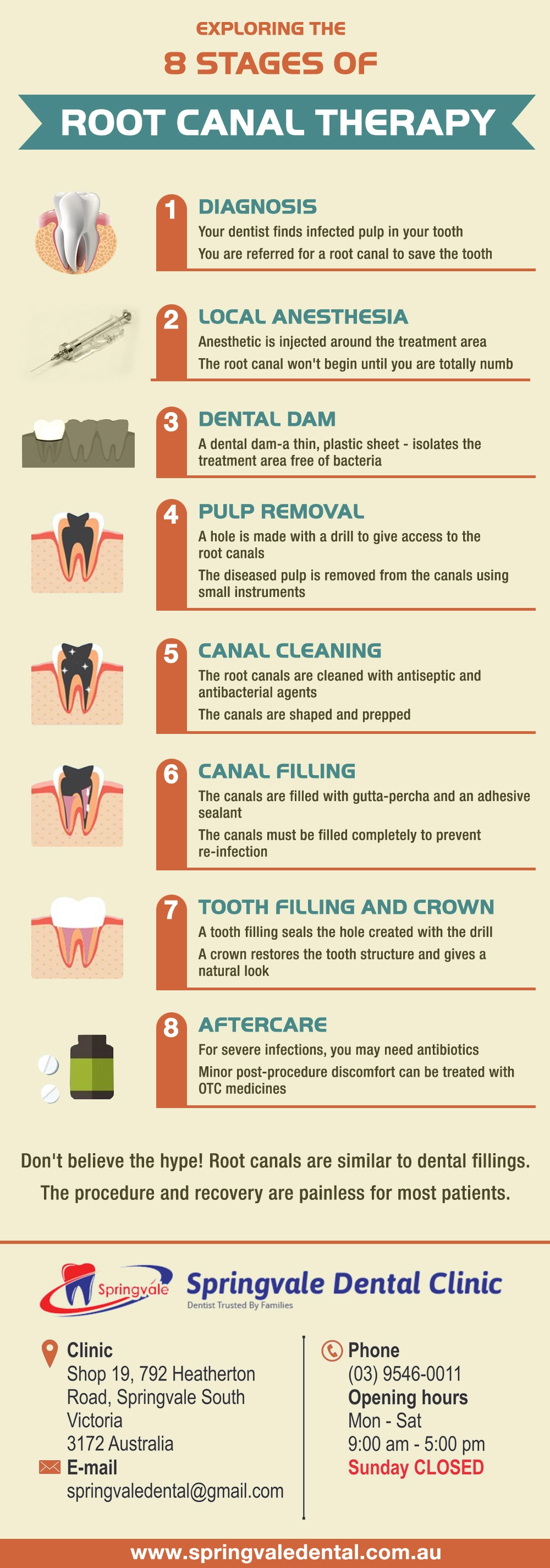
Root canal therapy is one of the most common dental procedures performed today, yet it remains shrouded in misconceptions and anxiety for many patients. Despite its reputation, modern root canal treatment is relatively comfortable and crucial in saving teeth that would otherwise need extraction. At Springvale Dental Clinic, understanding each stage of the process can help alleviate concerns and prepare you for this tooth-saving procedure.
Root canal therapy (endodontic treatment) is a dental procedure designed to treat infection or inflammation in a tooth's pulp. The pulp contains nerves, blood vessels, and connective tissue that can become infected due to deep decay, repeated dental procedures, cracks, or trauma. Left untreated, this infection can lead to severe pain, abscess, and eventually tooth loss.
Several signs may indicate the need for root canal therapy. These include severe toothache when chewing or applying pressure, prolonged sensitivity to hot or cold temperatures, discoloration of the tooth, swelling and tenderness in nearby gums, and persistent or recurring pimples on the gums. If you experience these symptoms, seeking dental care promptly is essential, as early intervention often leads to better outcomes.
Now, let's explore the eight stages of root canal therapy to demystify this essential dental procedure:
The journey begins with the proper diagnosis. Your dentist will examine the affected tooth, take dental X rays, and perform tests to determine if the pulp is damaged or infected. These tests might include temperature sensitivity checks, tapping the tooth to assess tenderness or electric pulp testing. Once root canal therapy is deemed necessary, your dentist will create a treatment plan tailored to your specific needs and discuss any concerns you might have about the procedure.
Before beginning the procedure, your dentist will administer local anesthesia to ensure you remain comfortable throughout the treatment. The anesthetic numbs the tooth and surrounding tissues, meaning you should feel no pain during the procedure – just some pressure or vibration. Modern anesthetics are highly effective, and many patients report that root canal therapy is no more uncomfortable than having a routine filling.
A thin rubber sheet called a dental dam is placed around the tooth. This critical step isolates the treatment area, keeping it clean and dry by preventing saliva and bacteria from contaminating the site. It also protects you from accidentally swallowing or inhaling dental materials or medications, ensuring your safety throughout the procedure.
Once the area is numb and isolated, your dentist creates a small opening in the crown (top) of the tooth to access the pulp chamber and root canals. This opening is made on the back surface of the front teeth, while molars are created on the chewing surface. Advances in dental instruments have made this step more precise and conservative, preserving as much healthy tooth structure as possible.
Your dentist removes the infected or inflamed pulp from the pulp chamber and root canals using specialized endodontic instruments. These wonderful instruments clean the canals while shaping them to prepare for filling. This stage is crucial for removing all infected tissue and creating the appropriate shape for successful filling. Modern rotary instruments and techniques have made this process more efficient and comfortable.
After cleaning and shaping, the canals are thoroughly disinfected with antimicrobial solutions. These solutions flush out debris and kill the remaining bacteria within the canal system. Sometimes, your dentist may place medication inside the tooth and temporarily seal it, requiring you to return for a second appointment to complete the procedure. This step is vital for ensuring the long-term success of the treatment.
Once the canals are clean, shaped, and disinfected, they're filled with a biocompatible gutta-percha material. This rubber-like material is placed with adhesive cement to seal the canals completely. Proper sealing prevents bacteria from re-entering the tooth and causing further infection. Today's filling techniques provide exceptional sealing ability, significantly improving the long-term prognosis of treated teeth.
The final stage involves restoring the tooth's structure and function. In most cases, a tooth that needs root canal therapy has significant decay or damage. After the root canal is complete, your dentist will place a filling or, more commonly, a crown to protect the tooth and restore full functionality. This final restoration is crucial for the long-term success of the treatment and allows you to chew, speak, and smile confidently.
After root canal therapy, it's normal to experience some sensitivity or mild discomfort for a few days, especially if there was pain or infection before the procedure. This discomfort can typically be managed with over-the-counter pain medications. Most patients can return to their normal activities the day after treatment.
To ensure proper healing, following your dentist's aftercare instructions is essential. These typically include avoiding chewing on the treated tooth until the final restoration is placed, maintaining excellent oral hygiene by brushing and flossing regularly, and attending all scheduled follow-up appointments. A tooth treated with root canal therapy can last a lifetime with proper care.
While tooth extraction might seem more straightforward, saving your natural tooth through root canal therapy offers numerous benefits. These include maintaining normal biting force and sensation, efficient chewing, natural appearance, and protection of other teeth from excessive wear or strain. Additionally, root canal treatment is typically less expensive than extraction, followed by implant placement or bridge work.
At Springvale Dental Clinic, our experienced team specializes in comfortable, effective root canal treatments. We utilize the latest techniques and technologies to ensure the best possible outcomes. Our dental professionals regularly attend continuing education courses to stay current with advances in endodontic treatment, ensuring you receive state-of-the-art care.
Our clinic is conveniently located at Shop 22, 792 Heatherton Road, Springvale South Victoria 3172, Australia, and we're open seven days a week from 9 am to 5 pm to accommodate your busy schedule. Whether you need emergency treatment for a painful tooth or have been referred for a root canal procedure, our flexible hours ensure you won't have to wait long for relief.
We understand that dental procedures can cause anxiety, so we take the time to explain each step of the process and ensure you're comfortable throughout your treatment. If you're experiencing tooth pain or have been told you need a root canal, don't delay seeking treatment. Contact Springvale Dental Clinic today, and let us help preserve your natural smile with our gentle and effective root canal therapy.
